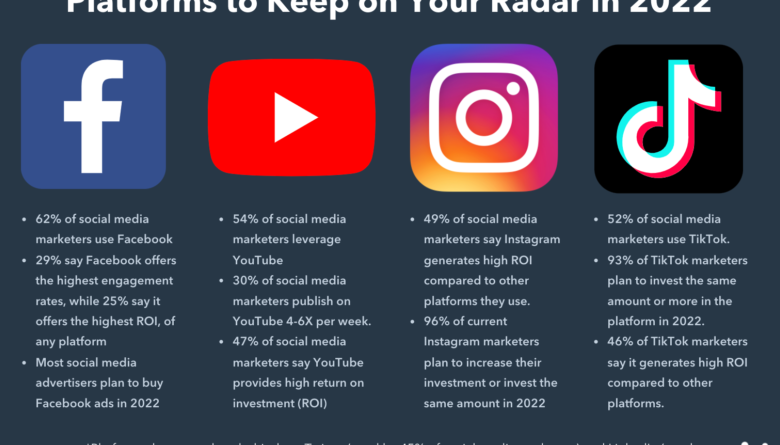The Most Used Social Media Platforms within the UK, and How to Advertise on Them Right

Social media usage within the UK is at an all-time high, with a huge number of active users on the variety of different platforms every day. For any business looking to target consumers in the UK, knowing which social media channels are the most popular, and how best to advertise on them, is paramount. In this article, we put a close eye on some of the most utilised social media in the UK, delve into the best advertisement methods, and look for better budgeting in order to be certain of the effectiveness of the campaigns.
1. Most Popular Social Media Platforms in the UK
Social media in the UK is highly varied, with different platforms serving different demographics and audiences. The top-rankings by user number and engagement are:
a. Facebook
It is one of the most used social networks in the UK, with about 44 million users, and it is really popular among all age groups. Because of this, it is perfect for those businesses looking for a general audience. A lot of people use it for personal and professional networking purposes since it’s really easy to follow favourite brand pages or community groups. Moreover, exemplary targeting makes the platform ideal for brands seeking to reach certain audiences.
b. Instagram
With over 30 million active users in the UK, Instagram is most popular among younger audiences, particularly those between 18-34 years. The platform, because of its nature, is ideal for industries such as fashion, beauty, travel, and lifestyle. Instagram Stories, Reels, and carousel posts provide a lot of leverage to brands when it comes to creative product and service showcases. Instagram is itself a powerful means of advertising, offering highly targeted campaigns.
c. TikTok
TikTok is fast gaining traction in the Gen Z audience, with an estimated 17 million users in the UK alone. In tune with the nature of its hosting only short-form videos, TikTok offers a plethora of possibilities through which brands can design creative and entertaining content-more often than not, light-hearted or humorous in nature. Brands can reach a younger, trend-driven audience on TikTok, especially through collaborations with social media influencers or participation in viral challenges.
d. LinkedIn
LinkedIn is the most-used professional networking platform in the UK, boasting over 30 million users within the country. It’s highly utilised by businesses, professionals, and organisations to share updates about their industry, job vacancies, and company news. LinkedIn does a very good job with targeting B2B audiences as well as targeting professionals based on industry, job title, or size of company. It’s a great platform for technology, finance, and professional services brands. e. Twitter
e. Twitter
It is estimated that around 16 million active users tweet or cause engagements in the UK alone. Due to this, Twitter becomes very famous among brands, public figures, and news due to its real-time updates and conversational tone. The age bracket on Twitter is very wide; however, this channel has been very famous among urban dwellers interested in current affairs, technology, and entertainment.
f. YouTube
YouTube is estimated to have 46 million monthly users in the UK alone, leading in this sector. The users span all age groups; hence, it is suitable for brands targeting a wide audience. This includes a long list of options on YouTube advertisements, such as skippable video ads, bumper ads, and sponsorships. It’s most effective for those brands that can create informative or entertaining video content, such as how-to tutorials, product reviews, or behind-the-scenes footage.
2. Most Effective Ways to Advertise on Social Media in the UK
To drive maximum ROI, one should craft an advertising strategy peculiar to each platform. Here are some of the most effective ways to advertise on social media in the UK:
a. Facebook and Instagram Targeted Ads
Both Facebook and Instagram have huge potential in offering highly targeted advertising options, such as allowing brands to detail audience demographics, interests, and behaviours. This may be in the form of ads that pop up through image or video posts within user feeds, in their Stories, and even in Reels. Strong targeting on Facebook lets brands capture certain audiences, whether users interested in specific products or even those living in certain locations. Additionally, Instagram happens to be a hub for visually driven companies, thus acting as an ideal choice for product-based businesses to showcase their range through captivating images or videos.
b. TikTok and Instagram- Influencer Marketing
Influencer marketing strategy works way better on TikTok and Instagram due to the fact that users on these two platforms are rather engaging and influenced by popular content creators. Brands can partner with the right influencers that show their brand values and target audience to increase credibility and reach a wider audience for their brand. With partnerships, through influencers, it is easier for brands to take advantage of the existing audience base that an influencer has established and enjoys more organic recommendations of their products. Influencer campaigns are considered very effective in the case of targeting young demographics like Gen Z and Millennials.
c. YouTube Video Ads
YouTube is an effective platform for reaching users with engaging video content. Brands can promote their products by making use of skippable ads, non-skippable ads, or bumper ads. YouTube ads work especially well for brands that have video content featuring a product or information. For example, beauty brands use YouTube to provide makeup tutorials, while tech companies create product demos. With this, a brand with a higher element of storytelling can make ads more interactive for their audience, improving engagement and conversion rates.
d) LinkedIn Sponsored Content for B2B
LinkedIn is the ideal ecosystem for B2B advertising because it allows brands to reach out not only to working professionals but also to businesses. For reaching decision-makers and executives, sponsored content-such as sponsored posts and InMail-work well. The platform offers a range of options with which brands can reach out to users based on their industry, job title, company size, and more. All these make it particularly useful for brands offering business services, software solutions, or consulting services.
3. How to Budget for Social Media Ads
Social media advertising budgets can vary a great deal, depending on the platform a person is using to advertise on, the ad format, and the size of the audience. Here’s a general idea of what one could expect on each of the platforms with respect to budget:
Facebook and Instagram: These systems normally work on either a CPC model or a CPM model. The average CPC for Facebook and Instagram in the UK ranges from £0.20 to £1.00 plus VAT, depending on audience size and ad placement. A budget of £500-£1,500 per month is sufficient for small to medium-sized campaigns.
TikTok Ads: As the CPC is higher on TikTok, these run from £0.50 up to £2.00. Influencer collaborations in TikTok may also be budget-friendly because this site is still in its developing stage. A certain budget of £1,000 to £2,000 per month is recommended to give meaningful results.
YouTube: YouTube often uses a CPV model, meaning video ads on this channel tend to average between £0.10 and £0.30 per ad view. For a small to medium-sized campaign, £1,000 to £2,500 will provide solid reach and engagement.
LinkedIn: It becomes a little pricier because of the professional audience; average CPCs lie between £3-£6 approximately. If one wants to effectively target professionals or decision-makers, B2B brands are suggested to have a budget of £1,500-£3,000 per month.
Twitter Ads Pricing: Again, targeting criteria- the average cost per click for Twitter ads ranges around £0.40 to £1.20. A budget of around £500-£1,000 per month should be good enough for running small campaigns, while larger budgets tend to maximise reach and engagement.
4. Effective Banner Ad Designs
Regardless of the platform, there’s a way to effectively design banner ads that will most definitely catch the attention of users and prompt them to engage with your content. In the case of banner ad designs, high-resolution images representing either a product or service clearly are used, together with urgent calls to action. Avoid clutter in the design; instead, use simple and clear language. Bold fonts, contrasting colours, and succinct copy mean the user can register instantly what the ad is trying to say. In the case of video-based banner ads, the opening few seconds will be critical if viewer retention is the goal. Conclusion
From the broad, general audience of Facebook to the young of TikTok and the professional network on LinkedIn, the UK social media landscape has a number of different platforms that brands can reach different demographics on. Carrying out effective social media advertising in the UK means targeted adverts, influencer marketing, and video content that engages, supported by budgets that are aligned to the varying costs across each platform. Knowing the intricacies of each platform and working out your strategy to fit each one means you’ll develop campaigns that drive engagement, capture the attention of British audiences, and yield meaningful results. Whether a small business or large company, the following strategies will maximise your social media advertising efforts in the UK.



